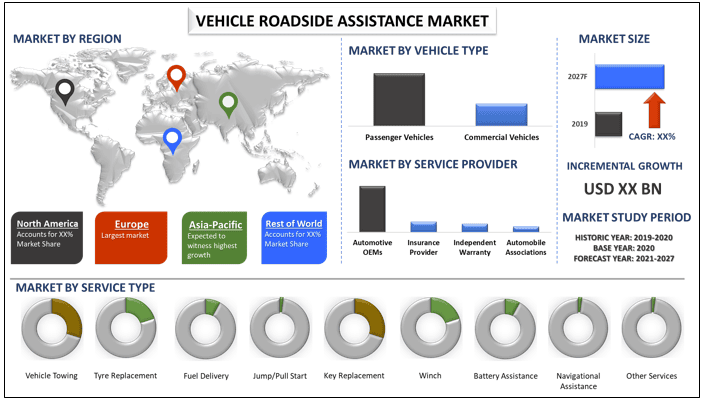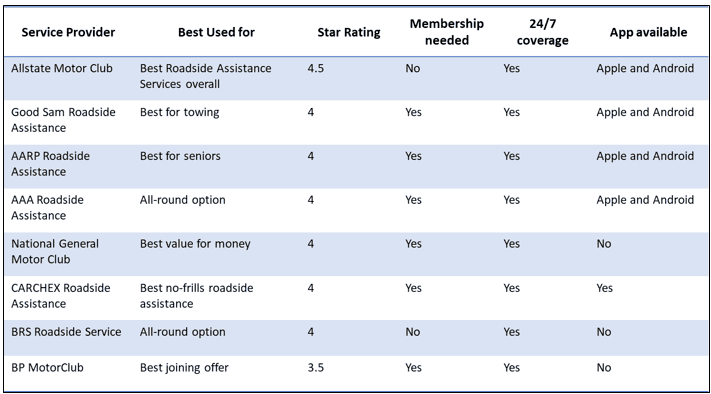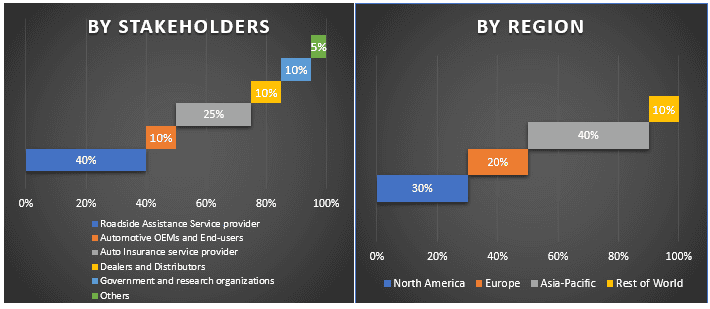- الرئيسية
- معلومات عنا
- صناعة
- الخدمات
- قراءة
- اتصل بنا
سوق المساعدة على الطريق للمركبات: التحليل الحالي والتوقعات (2021-2027)
التركيز على نوع الخدمة (قطر المركبات، استبدال الإطارات، توصيل الوقود، تشغيل/سحب المحرك، استبدال المفاتيح، الرافعة، مساعدة البطارية، المساعدة الملاحية، خدمات أخرى)؛ مزود الخدمة (مصنعي المعدات الأصلية للسيارات، مزود التأمين، الضمان المستقل، جمعيات السيارات)؛ نوع السيارة (مركبات الركاب، المركبات التجارية)؛ والمناطق/البلد

من المتوقع أن يشهد سوق المساعدة على الطريق للمركبات نموًا سنويًا مركبًا يزيد عن 4٪ خلال الفترة المتوقعة 2021-2027. تتسبب أعطال المركبات على جانب الطريق في ازدحام مروري وقد تعرض حياة الناس للخطر. كما أنه يدمر يوم السائقين (والركاب) الذين يتعين عليهم انتظار شاحنات السحب لساعات، مما يهدر وقتًا ثمينًا ويعطل جدولهم. المساعدة على الطريق هي إضافة اختيارية لتأمين السيارات الشخصي للسائقين والتي توفر مساعدة تشتد الحاجة إليها في حالة الإطارات المثقوبة ونقص البنزين وفشل البطارية والسحب وغيرها من المشكلات. بالإضافة إلى ذلك، تنتج السيارات المتصلة كميات هائلة من بيانات حالة السيارة واستخدامها، والتي يمكن أن تزود مقدمي خدمات المساعدة على الطريق بمعلومات حيوية عن السيارة مثل الموقع وحالة المحرك ورموز الخطأ ومستوى الوقود وضغط الإطارات وغير ذلك الكثير. يمكن استخدام هذه المعلومات لتحديد السبب الجذري للعطل والمسار المناسب للعمل، فضلاً عن التشجيع على المشاركة بشكل أسرع لتحسين جودة الخدمة وتجربة السائق. على سبيل المثال، CAA هي الشركة العملاقة في مجال المساعدة على الطريق في كندا، حيث تضم أكثر من 35000 سيارة سحب. تبدأ العضوية الأساسية للمسافرين لمسافات قصيرة عادةً بحوالي 75 دولارًا أمريكيًا سنويًا وتتضمن ما يصل إلى خمس مكالمات طوارئ وسحب لمسافة تصل إلى 10 كيلومترات لكل مكالمة. تبلغ تكلفة العضوية الإضافية حوالي 120 دولارًا وتسمح لك عادةً بسحب ما يصل إلى 200 كيلومتر.
مقارنة بين كبار مزودي خدمات المساعدة على الطريق، 2021
الرؤى المقدمة في التقرير
"من بين أنواع الخدمات، سيشهد قطاع سحب المركبات نموًا كبيرًا"
استنادًا إلى نوع الخدمة، يتم تقسيم سوق المساعدة على الطريق للمركبات إلى سحب المركبات، واستبدال الإطارات، وتوصيل الوقود، والبدء بالقفز/السحب، واستبدال المفاتيح، والرافعة، والمساعدة في البطارية، والمساعدة في الملاحة، والخدمات الأخرى. حاليًا، يعد قطاع سحب المركبات هو الخدمة الأكثر شيوعًا في سوق المساعدة على الطريق للمركبات. ومع ذلك، فإن مشاكل البطارية والمولد والإطارات المثقوبة والمشاكل الكهربائية والسخونة الزائدة والفشل الميكانيكي المتعلق بالمحرك أو ناقل الحركة أو المكابح هي الأسباب الأخرى الأكثر شيوعًا للأعطال.
"من بين مزودي الخدمة، تهيمن شريحة مصنعي المعدات الأصلية للسيارات على السوق في عام 2020"
استنادًا إلى مزود الخدمة، ينقسم سوق المساعدة على الطريق للمركبات إلى مصنعي المعدات الأصلية للسيارات ومقدمي التأمين والضمان المستقل وجمعيات السيارات. في عام 2020، كان مصنعو المعدات الأصلية للسيارات هم أكبر مزود لخدمة المساعدة على الطريق للمركبات. ومع ذلك، مع انتشار التأمين القائم على المستخدم، من المتوقع أن يشهد مقدمو التأمين نموًا كبيرًا في السوق.
"من بين أنواع المركبات، تهيمن شريحة مركبات الركاب على السوق"
استنادًا إلى نوع السيارة، يتم تقسيم السوق إلى مركبات الركاب والمركبات التجارية. حاليًا، فإن الطلب على المساعدة على الطريق للمركبات هو في الغالب طلب على شريحة مركبات الركاب. ومع ذلك، من المتوقع أن يؤدي الطلب المتزايد على المركبات المتصلة إلى زيادة الطلب على خدمة المساعدة على الطريق لقطاع المركبات التجارية.
"من المتوقع أن تشهد منطقة آسيا والمحيط الهادئ نموًا كبيرًا خلال الفترة المتوقعة"
لتحسين فهم الطلب على المساعدة على الطريق للمركبات، يتم تحليل السوق للمناطق الرئيسية بما في ذلك أمريكا الشمالية (الولايات المتحدة وكندا وبقية أمريكا الشمالية)؛ أوروبا (ألمانيا والمملكة المتحدة وفرنسا وإيطاليا وبقية أوروبا)؛ آسيا والمحيط الهادئ (الصين واليابان والهند وأستراليا وبقية منطقة آسيا والمحيط الهادئ)؛ وبقية العالم. تهيمن أوروبا على السوق في عام 2020، ومع ذلك، من المتوقع أن تشهد منطقة آسيا والمحيط الهادئ نموًا كبيرًا خلال الفترة المتوقعة. بعض اللاعبين الرئيسيين العاملين في السوق تشمل Good Sam Enterprise, LLC و Best Roadside Service و Auto Vantage و Allianz Global Assistance و AA plc و Allstate Insurance Company و Agero, Inc. و National General Insurance و HONK Technologies و Arabian Automobile Association.
أسباب شراء هذا التقرير:
- تتضمن الدراسة تحليلًا لحجم السوق والتنبؤات تم التحقق من صحته من قبل خبراء الصناعة الرئيسيين الموثوق بهم
- يقدم التقرير مراجعة سريعة للأداء العام للصناعة في لمحة
- يغطي التقرير تحليلاً متعمقًا لأقران الصناعة البارزين مع التركيز الأساسي على البيانات المالية الرئيسية للأعمال ومجموعة المنتجات واستراتيجيات التوسع والتطورات الأخيرة
- فحص مفصل للدوافع والقيود والاتجاهات الرئيسية والفرص السائدة في الصناعة
- تغطي الدراسة بشكل شامل السوق عبر قطاعات مختلفة
- تحليل متعمق على المستوى الإقليمي للصناعة
خيارات التخصيص:
يمكن تخصيص سوق المساعدة على الطريق للمركبات بشكل أكبر وفقًا للمتطلبات أو أي قطاع سوق آخر. إلى جانب ذلك، تدرك UMI أن لديك احتياجات عمل خاصة بك، لذا لا تتردد في التواصل معنا للحصول على تقرير يناسب متطلباتك تمامًا.
جدول المحتويات
كان تحليل السوق التاريخي، وتقدير السوق الحالي، والتنبؤ بمستقبل خدمة المساعدة على الطريق للمركبات هي الخطوات الرئيسية الثلاث التي تم اتخاذها لإنشاء وتحليل الطلب على خدمة المساعدة على الطريق على مستوى العالم. تم إجراء بحث ثانوي شامل لجمع أرقام السوق التاريخية وتقدير حجم السوق الحالي. ثانيًا، للتحقق من صحة هذه الأفكار، تم أخذ العديد من النتائج والافتراضات في الاعتبار. علاوة على ذلك، تم إجراء مقابلات أولية شاملة مع خبراء الصناعة عبر سلسلة القيمة الخاصة بالصناعة. بعد افتراض أرقام السوق والتحقق من صحتها من خلال المقابلات الأولية، استخدمنا نهجًا تصاعديًا للتنبؤ بحجم السوق الكامل. بعد ذلك، تم اعتماد طرق تقسيم السوق وتثليث البيانات لتقدير وتحليل حجم سوق القطاعات والقطاعات الفرعية التي تنتمي إليها الصناعة. يتم شرح المنهجية التفصيلية أدناه.
تحليل حجم السوق التاريخي
الخطوة 1: دراسة متعمقة للمصادر الثانوية:
تم إجراء دراسة ثانوية مفصلة للحصول على حجم السوق التاريخي لخدمة المساعدة على الطريق للمركبات من خلال مصادر داخلية للشركة مثل التقرير السنوي والبيانات المالية وعروض الأداء والنشرات الصحفية وما إلى ذلك، ومصادر خارجية بما في ذلك المجلات والأخبار والمقالات والمنشورات الحكومية ومنشورات المنافسين وتقارير القطاعات وقاعدة بيانات الطرف الثالث والمنشورات الموثوقة الأخرى.
الخطوة 2: تجزئة السوق:
بعد الحصول على حجم السوق التاريخي لخدمة المساعدة على الطريق للمركبات، أجرينا تحليلًا ثانويًا مفصلاً لجمع رؤى السوق التاريخية وحصصها للقطاعات والقطاعات الفرعية المختلفة للمناطق الرئيسية. تشمل القطاعات الرئيسية المضمنة في التقرير نوع الخدمة ومقدم الخدمة ونوع السيارة. تم إجراء المزيد من التحليلات على المستوى الإقليمي لتقييم الطلب الإجمالي على خدمة المساعدة على الطريق للمركبات في السياق العالمي.
الخطوة 3: تحليل العوامل:
بعد الحصول على حجم السوق التاريخي للقطاعات والقطاعات الفرعية المختلفة، أجرينا تحليلًا للعوامل بالتفصيل لتقدير حجم السوق الحالي. علاوة على ذلك، أجرينا تحليلًا للعوامل باستخدام متغيرات تابعة ومستقلة مثل الطلب المتزايد على حلول اتصال المركبات والطلب المتزايد على حلول سلامة المركبات والمساعدة مثل الحلول القائمة على السحابة للكشف المبكر عن المخاطر وما إلى ذلك. تم تحليل الاتجاهات التاريخية وتأثيرها السنوي على حجم السوق وحصته. كما تمت دراسة سيناريو العرض والطلب بدقة.
تقدير حجم السوق الحالي والتنبؤ به
تحديد حجم السوق الحالي: بناءً على رؤى قابلة للتنفيذ من الخطوات الثلاث المذكورة أعلاه، توصلنا إلى حجم السوق الحالي واللاعبين الرئيسيين في السوق والحصص السوقية للقطاعات والشركات. تم تحديد جميع تقسيمات النسب المئوية المطلوبة وتقسيمات السوق باستخدام النهج الثانوي المذكور أعلاه وتم التحقق منها من خلال المقابلات الأولية.
التقدير والتنبؤ: لتقدير السوق والتنبؤ به، تم تعيين أوزان لعوامل مختلفة بما في ذلك المحركات والاتجاهات والقيود والفرص المتاحة لأصحاب المصلحة. بعد تحليل هذه العوامل، تم تطبيق تقنيات التنبؤ ذات الصلة، أي النهج التصاعدي، للتوصل إلى توقعات السوق حتى عام 2027 للقطاعات والقطاعات الفرعية المختلفة عبر المناطق الرئيسية على مستوى العالم. تشمل منهجية البحث المعتمدة لتقدير حجم السوق:
- حجم سوق الصناعة، من حيث القيمة (بالدولار الأمريكي) والطلب على خدمة المساعدة على الطريق للمركبات في المناطق الرئيسية على مستوى العالم
- جميع الحصص المئوية وتقسيمات وتوزيعات القطاعات والقطاعات الفرعية في السوق
- اللاعبون الرئيسيون في سوق خدمة المساعدة على الطريق للمركبات من حيث المنتجات المعروضة. أيضًا، استراتيجيات النمو التي يتبناها هؤلاء اللاعبون للتنافس في السوق سريعة النمو.
التحقق من صحة حجم السوق وحصته
البحث الأولي: تم إجراء مقابلات متعمقة مع قادة الرأي الرئيسيين (KOLs) بما في ذلك كبار المديرين التنفيذيين (CXO/VPs، رئيس قسم المبيعات، رئيس قسم التسويق، رئيس العمليات، والرئيس الإقليمي، الرئيس القطري، وما إلى ذلك) عبر البلدان الرئيسية. ثم تم تلخيص نتائج البحث الأولي وإجراء تحليل إحصائي لإثبات الفرضية المذكورة. تم دمج المدخلات من البحث الأولي مع النتائج الثانوية، وبالتالي تحويل المعلومات إلى رؤى قابلة للتنفيذ.
تقسيم المشاركين الأساسيين في مناطق مختلفة
هندسة السوق
تم استخدام تقنية تثليث البيانات لإكمال تقدير السوق الإجمالي والتوصل إلى أرقام إحصائية دقيقة لكل قطاع فرعي وقطاع فرعي من سوق خدمة المساعدة على الطريق للمركبات. تم تقسيم البيانات إلى عدة قطاعات وقطاعات فرعية بعد دراسة المعلمات والاتجاهات المختلفة في مجالات نوع الخدمة ومقدم الخدمة ونوع السيارة والمنطقة.
الهدف الرئيسي من دراسة سوق خدمة المساعدة على الطريق للمركبات
يتم تحديد اتجاهات السوق الحالية والمستقبلية لسوق خدمة المساعدة على الطريق للمركبات في الدراسة. يمكن للمستثمرين الحصول على رؤى استراتيجية لأسس تقديرهم للاستثمارات من التحليل النوعي والكمي الذي يتم إجراؤه في الدراسة. ستحدد اتجاهات السوق الحالية والمستقبلية الجاذبية الإجمالية للسوق على المستوى الإقليمي، مما يوفر منصة للمشارك الصناعي لاستغلال السوق غير المستغلة للاستفادة كميزة المبادرة الأولى. تشمل الأهداف الكمية الأخرى للدراسات ما يلي:
- تحليل حجم السوق الحالي والمتوقع لخدمة المساعدة على الطريق للمركبات من حيث القيمة (بالدولار الأمريكي). أيضًا، قم بتحليل حجم السوق الحالي والمتوقع للقطاعات والقطاعات الفرعية المختلفة في الصناعة
- تشمل القطاعات في الدراسة نوع الخدمة ومقدمي الخدمة ونوع السيارة والمناطق
- تحليل محدد للإطار التنظيمي لصناعة خدمة المساعدة على الطريق للمركبات
- تحليل سلسلة القيمة التي تنطوي على وجود وسطاء مختلفين، جنبًا إلى جنب مع تحليل سلوكيات العملاء والمنافسين المتعلقة بالصناعة
- تشمل المناطق الرئيسية التي تم تحليلها في التقرير أمريكا الشمالية (الولايات المتحدة وكندا وبقية أمريكا الشمالية)؛ أوروبا (ألمانيا والمملكة المتحدة وفرنسا وإيطاليا وبقية أوروبا)؛ منطقة آسيا والمحيط الهادئ (الصين واليابان والهند وأستراليا وبقية منطقة آسيا والمحيط الهادئ)؛ وبقية العالم. تحديد وتحليل المشهد التنافسي لقطاع خدمة المساعدة على الطريق للمركبات واستراتيجيات النمو التي يتبناها اللاعبون في السوق للاستمرار في السوق سريعة النمو
تحليل متعمق على المستوى الإقليمي للصناعة
ذات صلة التقارير
العملاء الذين اشتروا هذا المنتج اشتروا أيضًا










